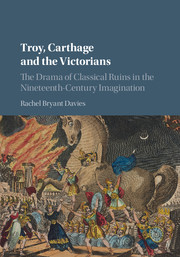 Troy, Carthage and the Victorians
Troy, Carthage and the Victorians Book contents
- Frontmatter
- Contents
- List of Plates
- List of Figures
- Acknowledgements
- Prologue
- 1 Introduction: The Ruins of Troy and Carthage ‘Still Flaming to the Imagination’ in the Nineteenth Century
- 2 ‘An Imaginary Troy’: Homeric Pilgrimage, Topography and Archaeology
- 3 ‘Not Classic, but Quite Correct’: The Trojan War at the Circus
- 4 Freely Perverted from Classic Texts’: The Iliad and Aeneid Burlesqued
- 5 ‘Sitting Among the Bricks of Covent Garden’: Carthage and the Future Ruins of the Nineteenth Century
- Epilogue: Troy and Carthage as ‘A Beacon and a Warning’
- Appendix A List of Burlesques
- Appendix B Select Chronology
- References
- Index
Prologue
Published online by Cambridge University Press: 03 March 2018
- Frontmatter
- Contents
- List of Plates
- List of Figures
- Acknowledgements
- Prologue
- 1 Introduction: The Ruins of Troy and Carthage ‘Still Flaming to the Imagination’ in the Nineteenth Century
- 2 ‘An Imaginary Troy’: Homeric Pilgrimage, Topography and Archaeology
- 3 ‘Not Classic, but Quite Correct’: The Trojan War at the Circus
- 4 Freely Perverted from Classic Texts’: The Iliad and Aeneid Burlesqued
- 5 ‘Sitting Among the Bricks of Covent Garden’: Carthage and the Future Ruins of the Nineteenth Century
- Epilogue: Troy and Carthage as ‘A Beacon and a Warning’
- Appendix A List of Burlesques
- Appendix B Select Chronology
- References
- Index
Summary
It is a tale of Troy – nothing less than the Giant Horse himself! There he is – surrounded by horses as gigantic and marvellous in their powers and accomplishments as himself – steeds of magical capacity.
Anon., Newspaper Clipping, 14 August 1833.With right foreleg raised, a horse is poised as if ready to charge into the flaming city. Its inclined head fixes viewers and soldiers alike with a quizzical eye. Etched lines indicate wooden planks, while soldiers excitedly peer from their hiding place. Yet the sinuously curving tail and artfully placed characters who hide the platform wheels, as well as the absence of the horses which drew that platform onto the stage in the original performance, lend an urgent vitality to the scene. This Giant Horse upstages all other characters in the spectacular theatrical souvenir depicted on the cover of this book, just as it dominated advertisements and reviews. This surprisingly lifelike depiction was an appropriate emblem for an ‘entirely new horse spectacle’ at Astley's Amphitheatre.
A beloved London venue which combined theatrical stage with circus arena, Astley's was widely acclaimed as the ‘favourite summer resort alike of the infant and the adult’. Even by this venue's exceptional standards, the entertainment depicted here was a phenomenal success. Described by a leading daily paper as ‘one of the best dramas of the class to which it pertains that we have ever witnessed’, The Giant Horse; or, The Siege of Troy delighted audiences with a solid run from Easter Monday throughout the record-setting heatwave season of 1833. In early August, the theatre was even lit up to celebrate the show's hundredth night: an emerging custom for what was, then, a truly remarkable achievement. Of course the illuminated edifice provided further advertisement, although eye-catching playbills had already attracted crowds. Journalists were breathless in their praise of the ‘striking originality’ with which this epic legend was brought to life – but some were damning in their criticism of fellow spectators at this ‘burlesque in the stables’.
Oddly, few seemed concerned that Menelaus was ‘Troy's proud hero’ and Paris ‘the Grecian prince’. All over the capital, extravagantly worded adverts competed for column space in newspapers, while posters and billboards jostled for bypassers’ attention.
- Type
- Chapter
- Information
- Troy, Carthage and the VictoriansThe Drama of Classical Ruins in the Nineteenth-Century Imagination, pp. 1 - 4Publisher: Cambridge University PressPrint publication year: 2018


